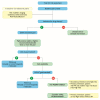Diagnosis and Management of Cardiovascular Risk in Patients with Polycythemia Vera
- PMID: 38025519
- PMCID: PMC10676644
- DOI: 10.2147/VHRM.S429995
Diagnosis and Management of Cardiovascular Risk in Patients with Polycythemia Vera
Abstract
Polycythemia vera (PV) is a myeloproliferative neoplasm characterized by aberrant myeloid lineage hematopoiesis with excessive red blood cell and pro-inflammatory cytokine production. Patients with PV present with a range of thrombotic and hemorrhagic symptoms that affect quality of life and reduce overall survival expectancy. Thrombotic events, transformation into acute myeloid leukemia, and myelofibrosis are largely responsible for the observed mortality. Treatment of PV is thus primarily focused on symptom control and survival extension through the prevention of thrombosis and leukemic transformation. Patients with PV frequently experience thrombotic events and have elevated cardiovascular risk, including hypertension, dyslipidemias, obesity, and smoking, all of which negatively affect survival. To reduce the risk of thrombotic complications, PV therapy should aim to normalize hemoglobin, hematocrit, and leukocytosis and, in addition, identify and modify cardiovascular risk factors. Herein, we review what is currently known about the associated cardiovascular risk and propose strategies for diagnosing and managing patients with PV.
Keywords: cardiovascular risk; myeloproliferative neoplasms; polycythemia vera; thrombosis.
© 2023 Benevolo et al.
Conflict of interest statement
G.B. has been on the advisory board, and been a speaker for Novartis, Janssen, BMS-Celgene M.M. has received consultancy fees from Gilead srl. E.B. has been a speaker for Novartis, Alexion and Incyte. A.M. has taken part in an advisory board for Amgen. D.R. has been advisor for Blueprint Medicines and has received travel grants from Novartis. The authors report no other conflicts of interest in this work.
Figures
References
-
- Rungjirajittranon T, Owattanapanich W, Ungprasert P, Siritanaratkul N, Ruchutrakool T. A systematic review and meta-analysis of the prevalence of thrombosis and bleeding at diagnosis of Philadelphia-negative myeloproliferative neoplasms. BMC Cancer. 2019;19(1):184. doi:10.1186/s12885-019-5387-9 - DOI - PMC - PubMed



